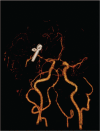A case report on middle cerebral artery aneurysm treated by rapid ventricular pacing: A CARE compliant case report
- PMID: 30508924
- PMCID: PMC6283198
- DOI: 10.1097/MD.0000000000013320
A case report on middle cerebral artery aneurysm treated by rapid ventricular pacing: A CARE compliant case report
Abstract
Rationale: Cerebral aneurysm is a common cause of intracranial hemorrhage, stroke, and death. It is treated with vascular surgeries, such as coil embolism and artery clipping. However, surgery itself is a risk factor that may cause rupture of aneurysm, and leads to irreversible brain damage, and even death. Rapid ventricular pacing (RVP) is a procedure that temporarily lowers blood pressure by increasing heart rate and reducing ventricular filling time. RVP has been widely used to reduce blood vessel tension in many cardiovascular surgeries.
Patient concerns: A 46-year-old man came to our hospital with intermittent right-side headache for 5 years, and left lower limb numbness for 3 months.
Diagnoses: Magnetic resonance imaging (MRI) of the head and digital subtraction angiography confirmed the diagnosis of right middle cerebral artery (MCA) aneurysm.
Interventions: Considering the large size of this MCA aneurysm, RVP was used to reduce blood pressure during MCA aneurysm repair, and to lower the risk of intracranial hemorrhage during procedure.
Outcomes: Post procedure, there was no abnormality detected. Seven weeks after surgery, the patient's muscle tone of right side extremities were grade V and left side extremities were grade IV. Computed tomography angiography confirmed no MCA aneurysm.
Lessons: In cases of aneurysm rupture, RVP will induce a transient "very low pressure" condition, and give a valuable time frame to clip the ruptured aneurysm. Therefore RVP is a safe and effective method to provide transient reduction of cardiac output in intracranial aneurysm patients.
Figures




Similar articles
-
Rapid ventricular pacing for clip reconstruction of complex unruptured intracranial aneurysms: results of an interdisciplinary prospective trial.J Neurosurg. 2018 Jun;128(6):1741-1752. doi: 10.3171/2016.11.JNS161420. Epub 2017 Aug 18. J Neurosurg. 2018. PMID: 28820303
-
[A Case of Ruptured Distal Anterior Choroidal Artery Aneurysm Associated with a Twig-Like Middle Cerebral Artery, Treated with Single-Stage Aneurysm Clipping and STA-MCA Double Anastomoses in the Acute Phase].No Shinkei Geka. 2017 Aug;45(8):691-697. doi: 10.11477/mf.1436203576. No Shinkei Geka. 2017. PMID: 28790215 Japanese.
-
Disappearance of Ruptured Posterior Cerebral Artery Aneurysm Associated with Internal Carotid Artery Occlusion After Superficial Temporal Artery-to-Middle Cerebral Artery Bypass.World Neurosurg. 2018 Aug;116:178-181. doi: 10.1016/j.wneu.2018.05.096. Epub 2018 May 23. World Neurosurg. 2018. PMID: 29803057
-
Ruptured MCA Aneurysm Mimicking MCA Territory Ischemic Stroke: A Case Report and Review of the Literature.J Neurol Surg A Cent Eur Neurosurg. 2022 May;83(3):283-285. doi: 10.1055/s-0040-1720995. Epub 2021 Feb 4. J Neurol Surg A Cent Eur Neurosurg. 2022. PMID: 33540448 Review.
-
Pure subdural haematoma caused by rupture of middle cerebral artery aneurysm: Case report and literature review.J Int Med Res. 2014 Jun;42(3):870-8. doi: 10.1177/0300060514524929. Epub 2014 Apr 1. J Int Med Res. 2014. PMID: 24691457 Review.
References
-
- Zacharia BE, Bruce SS, Carpenter AM, et al. Variability in outcome after elective cerebral aneurysm repair in high-volume academic medical centers. Stroke 2014;45:1447–52. - PubMed
-
- Brinjikji W, Lanzino G, Kallmes DF, et al. Cerebral aneurysm treatment is beginning to shift to low volume centers. J Neurointerv Surg 2014;6:349–52. - PubMed
-
- Guglielmi G, Vinuela F, Sepetka I, et al. Electrothrombosis of saccular aneurysms via endovascular approach. Part 1: electrochemical basis, technique, and experimental results. J Neurosurg 1991;75:1–7. - PubMed
-
- Pierot L, Cognard C, Anxionnat R, et al. Ruptured intracranial aneurysms: factors affecting the rate and outcome of endovascular treatment complications in a series of 782 patients (CLARITY study). Radiology 2010;256:916–23. - PubMed
-
- Elijovich L, Higashida RT, Lawton MT, et al. Predictors and outcomes of intraprocedural rupture in patients treated for ruptured intracranial aneurysms: the CARAT study. Stroke 2008;39:1501–6. - PubMed
Publication types
MeSH terms
LinkOut - more resources
Full Text Sources
Medical

